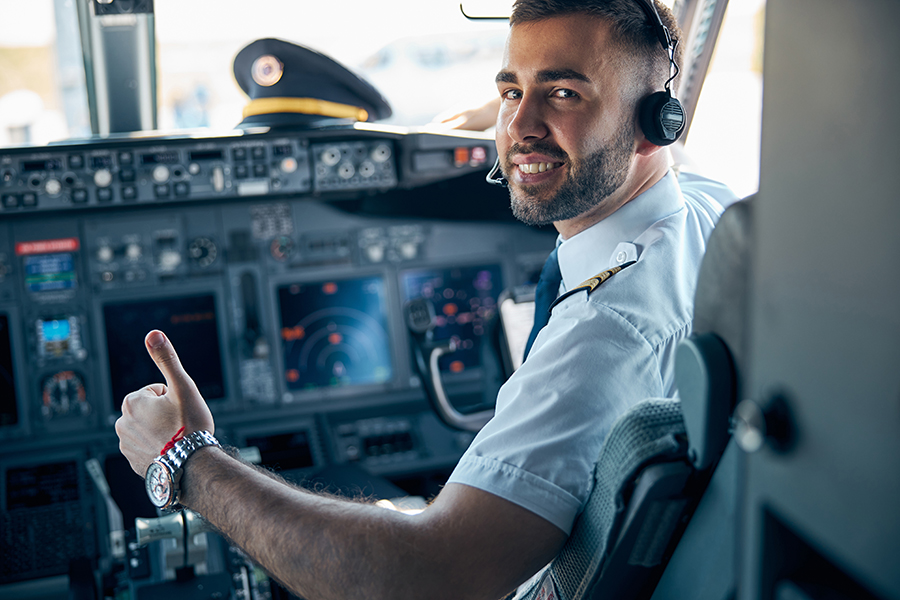-
Key Takeaways
-
What Is Ground Effect in Aviation?
-
Why Ground Effect Matters for Pilots
- Impact on Takeoff and Landing
- Compensating for Ground Effect
- Pilot Instruction and Evaluation
-
Ground Effect for Helicopters
- Improved Hover Efficiency
- In-Ground-Effect vs. Out-of-Ground-Effect Hover Efficiency
-
How to Recognize Ground Effect While Flying
- Changes in Control Inputs
- Typical Altitudes for Ground Effect
-
Ground Effect in Pilot Exams
- Common Test Questions
- Practical Flight Test Scenarios
-
Conclusion
You’re landing. You feel in control. But, as you near the runway, the airplane starts to float. It’s not magic—it’s ground effect.
When you’re flying near the ground, within one wingspan, the aerodynamic forces start to change.
Your wings don’t create as much drag as they would at higher altitudes, which gives you extra lift. This can make landing feel different, and not in a way you want if you’re expecting to touch down.
Let’s discuss what is happening beneath your wings. Ground effect is a phenomenon that every pilot must master.
Key Takeaways
- Ground effect increases an aircraft’s lift and decreases drag.
- It’s most noticed during takeoff and landing procedures.
- Helicopters experience better hover efficiency due to ground effect.
- Understanding ground effect helps improve flight safety.
What Is Ground Effect in Aviation?
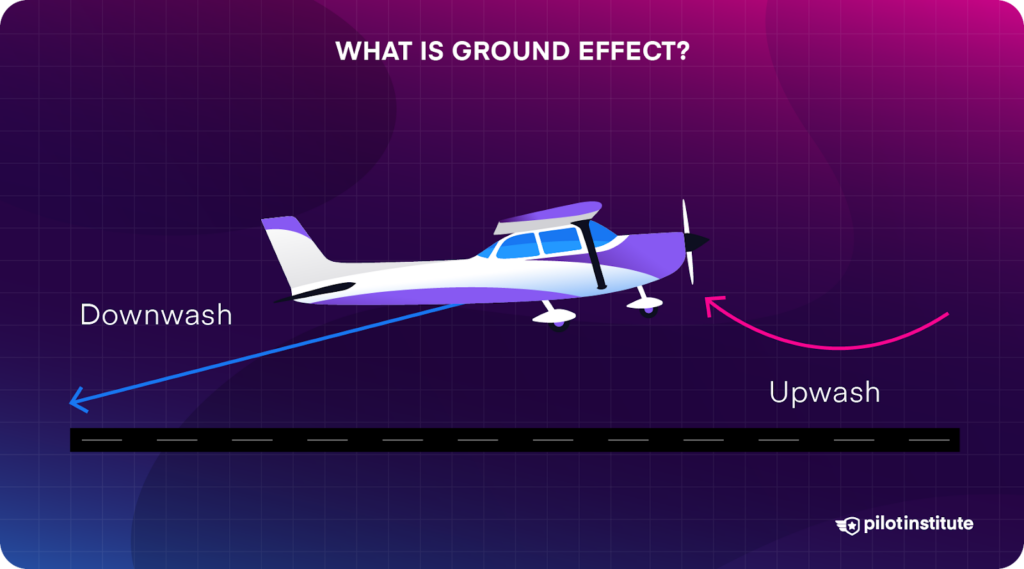
When an aircraft flies close to the ground, usually within one wingspan of the surface, a phenomenon known as ground effect occurs. The aircraft’s wings and the ground become cushioned by air, which causes some interesting aerodynamic changes.
When an aircraft enters ground effect, two things happen. Lift increases due to the high-pressure area created by the compressed air beneath the wings. Secondly, induced drag decreases due to the ground disturbing the wingtip vortices.
Don’t worry if this sounds confusing. Just remember that ground effect causes an aircraft to float. The aircraft will float and try to takeoff too early or float over the runway and delay touchdown while landing.
That’s how ground effect can dramatically alter an aircraft’s performance. As a pilot, you must have a good understanding of ground effect to maintain control and make the required adjustments during important flight stages.
Why Ground Effect Matters for Pilots
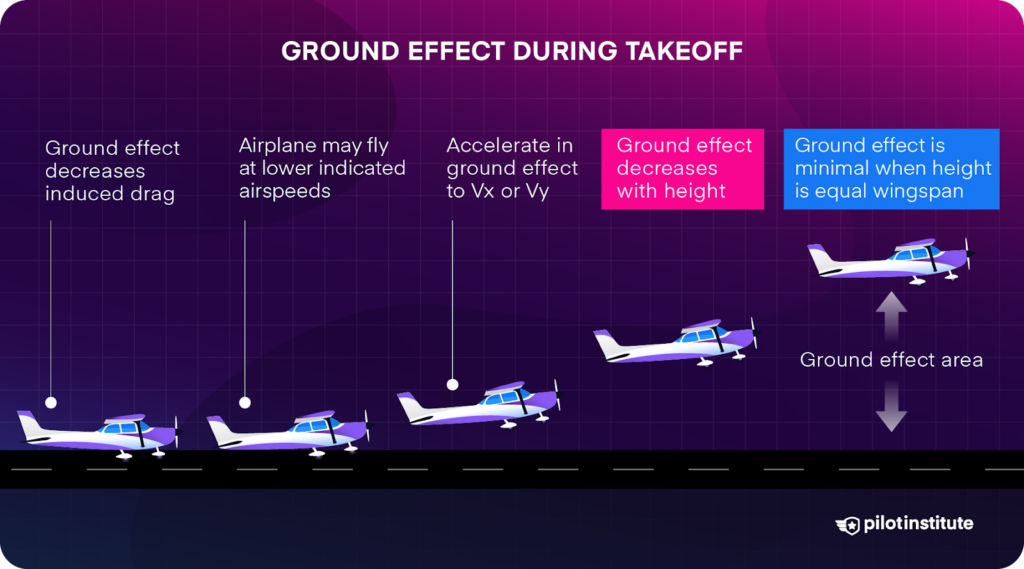
As we have learned, ground effect is an aerodynamic phenomenon that impacts an aircraft during takeoff or landing. While calculating an aircraft’s performance, you must take into account ground effect, particularly when operating on short runways or in high-density altitude areas.
Let’s dive into why ground effect matters:
Impact on Takeoff and Landing
Ground effect can make an aircraft airborne/float before it reaches its V1 or the recommended rotation speed during takeoff. When an aircraft climbs out of ground effect it might not have enough airspeed to continue flying which could cause it to stall.
Conversely, an aircraft may float down the runway during landing due to the ground effect, making it challenging to make a smooth landing at the desired location. If not recognized in time, ground effect can result in runway overruns.
Compensating for Ground Effect
Learning how to adjust for the increased lift and decreased drag can help you compensate for ground effect. During the takeoff roll, only rotate at the set takeoff speed, even though the aircraft may feel ready to takeoff sooner. When landing, you’ll want to reduce power to ensure a timely touchdown and counter the floating effect.
Pilot Instruction and Evaluation
Both the written and practical exams will include questions about ground effect, as it has become fundamental to improving safety. According to the FAA, a pilot’s aeronautical knowledge must include ground effect training. So you may have to discuss and demonstrate this during your checkride.
Ground Effect for Helicopters
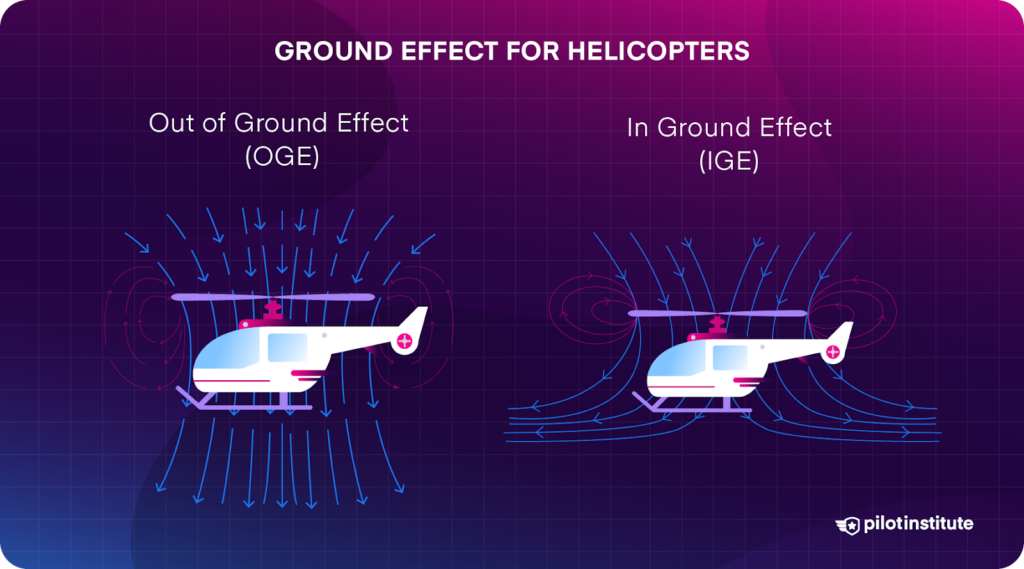
Unlike fixed-wing aircraft, ground effect impacts helicopters during their hover operations. A helicopter experiences ground effect when it hovers within one rotor diameter above the ground. Here’s what you need to know:
Improved Hover Efficiency
Ground effect on a helicopter causes less drag and improves performance. This allows the helicopter to hover with less power than needed (such as at high altitudes) as a result of the improved hover efficiency.
In-Ground-Effect vs. Out-of-Ground-Effect Hover Efficiency
Depending on the distance from the ground, a helicopter can experience two types of ground effect. Let’s take a look at the two types of hovering effects:
- In-Ground-Effect: When a helicopter is close to the ground, it can take advantage of ground effect. This is when an In-Ground-Effect (IGE) hover occurs, which causes increased performance and requires less power to hover.
- Out-of-Ground-Effect: In contrast, when a helicopter is above one rotor diameter, ground effect gets eliminated, resulting in an Out-of-Ground-Effect (OGE) hover. This means that the helicopter will require more power to maintain altitude.
Depending on the design of the helicopter and the surrounding terrain, an IGE hover may require 10–20% less power than an OGE hover. Helicopter pilots must know about these differences when planning flight operations, especially in scenarios involving high altitude or heavy loads.
How to Recognize Ground Effect While Flying
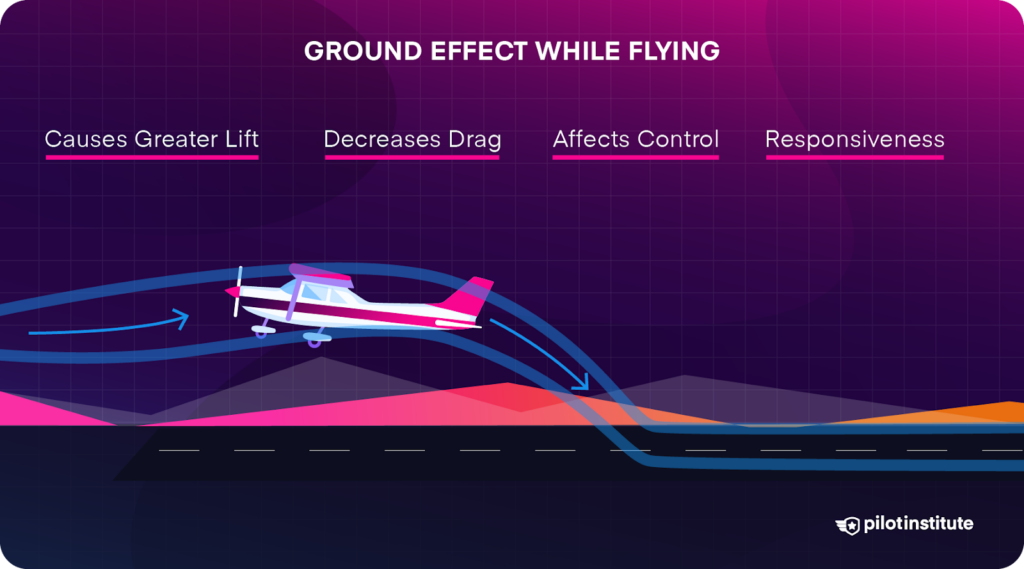
While flying an aircraft, it’s important for you to know when you have encountered ground effect. Start by observing the following warning signs:
- Greater Lift: As you get closer to the ground, the aircraft might feel lighter and more buoyant.
- Decreased Drag: While taking off, you may notice that the aircraft accelerates more quickly or uses less power to maintain its speed when landing.
- Control Responsiveness: The aircraft’s control responsiveness may change, making it feel more susceptible to inputs, particularly when pitching.
Changes in Control Inputs
If you encounter ground effect while flying, consider making the following adjustments:
- Prevent early rotation during takeoff by lowering the back pressure on the yoke or stick.
- Perform a power reduction to reach the desired descent rate when landing.
- Apply slightly more forward pressure to counteract floating during landing.
Typical Altitudes for Ground Effect
The type of aircraft and altitude have a direct impact on the intensity of ground effect. In most cases, ground effect occurs when an aircraft flies at an altitude that is either the same as or lower than its wingspan.
For example, a Cessna 172 with a 36-foot wingspan will begin to experience ground effect between 30 and 36 feet Above Ground Level (AGL). Whereas a Boeing 747 that has a wingspan of 211 feet, the ground effect can occur as high as 200 feet AGL.
Also note that ground effect increases as you get closer to the ground. The fundamentals of ground effect apply to small and large commercial aircraft, and understanding them will help you become a better pilot.
Ground Effect in Pilot Exams
Besides preparing for practical testing and pilot certification exams, learning about ground effect is essential for flying in real-world situations.
Common Test Questions
Questions such as these may appear on FAA written exams:
- How does ground effect impact induced drag?
- What is the average height above the runway at which you experience ground effect?
- How does ground effect impact an aircraft’s takeoff performance?
Be ready to discuss ground effect and the practical implications on flight operations as well as the underlying aerodynamic principles.
Practical Flight Test Scenarios
Your FAA examiner may use examples like the following to gauge how well you understand ground effect during your checkride.
- Ask how you would offset for ground effect in the event of a short-field takeoff.
- Make you demonstrate a landing and mention the moment you enter ground effect.
- Ask how you would modify the landing or takeoff sequence depending on the wind and ground effect.
Examiners want to see that you can apply the knowledge you have learned in the classroom to actual flying situations, so keep that in mind when you study. Most importantly, you need to handle flying near-ground phases by identifying the symptoms of ground effect, predicting how it will affect your aircraft’s performance, and knowing how to compensate for it.
Conclusion
Ground effect isn’t something you can just ignore. It shows up when you’re flying low and forces you to adjust. As you gain more practice, you’ll get a feel for how your aircraft handles that extra lift close to the ground.
Knowing when it’ll kick in and how to adjust will help you avoid bouncy takeoffs and long landings. Ground effect can either be your best friend or something you need to fight.
And trust me, you don’t want to be the pilot still floating halfway down the runway after you expected to land much sooner.
Safe flying!

